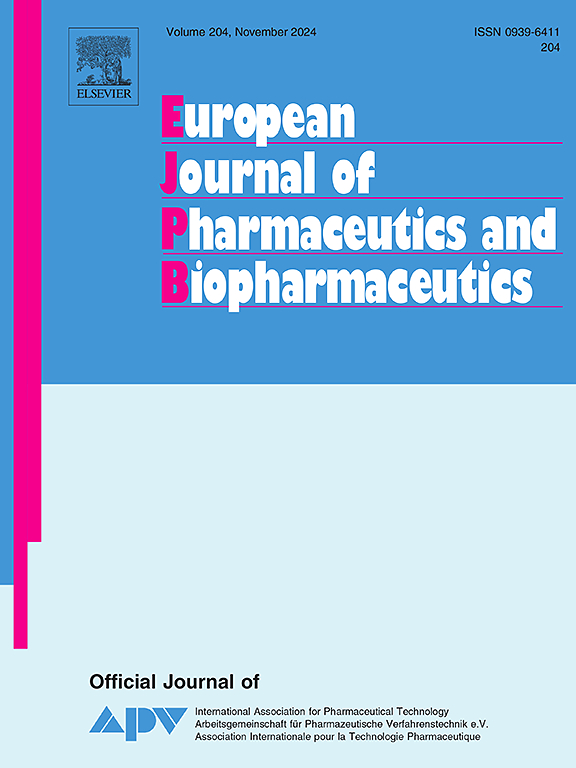空心羟基磷灰石微胶囊的载药机制
IF 4.3
2区 医学
Q1 PHARMACOLOGY & PHARMACY
European Journal of Pharmaceutics and Biopharmaceutics
Pub Date : 2025-06-13
DOI:10.1016/j.ejpb.2025.114785
引用次数: 0
摘要
无机羟基磷灰石微胶囊是为口服给药量身定制的创新给药装置。它们被设计为新型赋形剂,即所谓的模板反转颗粒(TIP),以协助制备口腔崩解片。本研究使用11种临床相关药物表征了所有BCS类别的药物负荷能力,重点是咪达唑仑、伊维菌素、布洛芬和苯甲硝唑。所有研究药物的载药量均高达45% (v/v)。负载的TIP压实后的片剂具有机械稳定性,抗拉强度高达6mpa,与水接触后几秒钟就会崩解。微胶囊的高比表面积和某些被测药物由于空间限制而抑制结晶可以解释被封装药物的加速溶解。有效的药物装载到TIP的内部中空腔结构是由自装载机制促进的,消除了复杂的药物特异性装载策略的需要。提出了一个数学模型来描述TIP的自加载机制,该机制负责在颗粒腔内的专属药物沉积。我们证明TIP作为一种多功能且具有成本效益的平台技术,具有促进患者友好型药物的配方开发过程的潜力。本文章由计算机程序翻译,如有差异,请以英文原文为准。

Drug loading mechanism of hollow hydroxyapatite microcapsules
Inorganic hydroxyapatite microcapsules are innovative drug delivery devices tailored for oral drug delivery. They were designed as novel excipients, the so-called template inverted particles (TIP), to assist in preparing the orally disintegrating tablets. This study characterized the drug loading capacity using 11 clinically relevant drugs covering all BCS classes, focusing on midazolam HCl, ivermectin, ibuprofen, and metronidazole benzoate. An exceptionally high drug loading capacity of 45 % (v/v) was observed for all studied drugs. Compaction of loaded TIP resulted in mechanically stable tablets with tensile strengths of up to 6 MPa and disintegrating in a few seconds upon contact with water. Accelerated dissolution of encapsulated drugs is explained by the microcapsules’ high specific surface area and the inhibited crystallization due to spacial constraints for some tested drugs. Efficient drug loading into TIP’s internal hollow cavity structure is facilitated by a self-loading mechanism, eliminating the need for complex, drug-specific loading strategies. A mathematical model is presented to describe the self-loading mechanism of TIP, which is responsible for exclusive drug deposition within the cavity of the particles. We demonstrate that TIP, being a versatile and cost-effective platform technology, has the potential to facilitate the formulation development process of patient-friendly medicines.
求助全文
通过发布文献求助,成功后即可免费获取论文全文。
去求助
来源期刊
CiteScore
8.80
自引率
4.10%
发文量
211
审稿时长
36 days
期刊介绍:
The European Journal of Pharmaceutics and Biopharmaceutics provides a medium for the publication of novel, innovative and hypothesis-driven research from the areas of Pharmaceutics and Biopharmaceutics.
Topics covered include for example:
Design and development of drug delivery systems for pharmaceuticals and biopharmaceuticals (small molecules, proteins, nucleic acids)
Aspects of manufacturing process design
Biomedical aspects of drug product design
Strategies and formulations for controlled drug transport across biological barriers
Physicochemical aspects of drug product development
Novel excipients for drug product design
Drug delivery and controlled release systems for systemic and local applications
Nanomaterials for therapeutic and diagnostic purposes
Advanced therapy medicinal products
Medical devices supporting a distinct pharmacological effect.

 求助内容:
求助内容: 应助结果提醒方式:
应助结果提醒方式:


